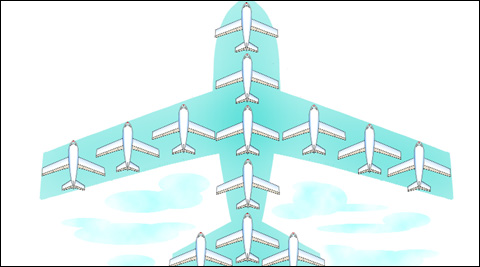New aviation norms will dramatically affect the way airlines operate —
as well as their bottom line — as they mandate that, in another two
years, airlines have to fly as much on regional routes as they do on
trunk routes.
In the process, a new formula has been suggested to achieve this, one which will give a fillip to non-scheduled airlines like Invision Air and Freedom Airways which could now have code-sharing arrangements with the likes of Air India, Jet Airways, SpiceJet and Indigo.
While airlines are still studying the impact of the guidelines — an executive of one of the top three domestic airlines said implementation would be a challenge given the losses they made — KPMG’s India head of aerospace Amber Dubey said that “the draft policy shows greater understanding of the genuine problems being faced by airlines”. Amber added the obligations — an equal capacity has to be deployed on trunk and non-trunk routes by winter 2016 — seemed “a bit excessive”.
The industry has accumulated losses of R49,000 crore — only IndiGo and GoAir are currently recording profits, while both Jet and SpiceJet reported losses of over R4,000 crore and R1,003 crore in FY14.
The term Category I/II /III airports has been given up in favour of trunk and regional routes, so an apples to apples comparison is difficult. Broadly speaking, if airlines fly around a third of flights in regional routes right now, this has to be increased to half by winter 2016. If an airline has 100 available seat kilometres (ASKMs) deployed in trunk routes by winter 2016, a similar amount have to be deployed in regional routes.
Read news in full 30/08/14 Indian Express

In the process, a new formula has been suggested to achieve this, one which will give a fillip to non-scheduled airlines like Invision Air and Freedom Airways which could now have code-sharing arrangements with the likes of Air India, Jet Airways, SpiceJet and Indigo.
While airlines are still studying the impact of the guidelines — an executive of one of the top three domestic airlines said implementation would be a challenge given the losses they made — KPMG’s India head of aerospace Amber Dubey said that “the draft policy shows greater understanding of the genuine problems being faced by airlines”. Amber added the obligations — an equal capacity has to be deployed on trunk and non-trunk routes by winter 2016 — seemed “a bit excessive”.
The industry has accumulated losses of R49,000 crore — only IndiGo and GoAir are currently recording profits, while both Jet and SpiceJet reported losses of over R4,000 crore and R1,003 crore in FY14.
The term Category I/II /III airports has been given up in favour of trunk and regional routes, so an apples to apples comparison is difficult. Broadly speaking, if airlines fly around a third of flights in regional routes right now, this has to be increased to half by winter 2016. If an airline has 100 available seat kilometres (ASKMs) deployed in trunk routes by winter 2016, a similar amount have to be deployed in regional routes.
Read news in full 30/08/14 Indian Express










No comments:
Post a Comment